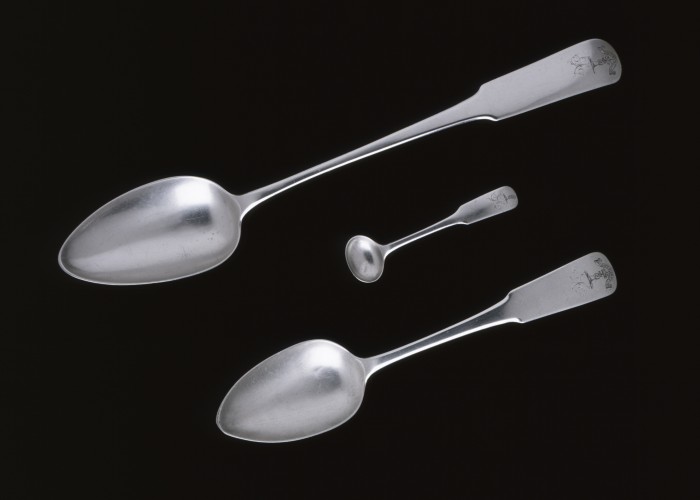Spoons Bought With Waterloo Prize Money
These three silver spoons were purchased by Assistant Surgeon Stewart Chisholm of the Ordnance Medical Department after the Battle of Waterloo. He used his prize money to buy them. This was a sum of money awarded to soldiers of the British Army after victories, paid from the value of captured enemy property. The spoils of war – French cannons, baggage, and money – were seen as a rightful reward for the conquering army. To commemorate his role in the famous victory, Chisholm had the spoons engraved with the words “Waterloo Prize Money”.
Waterloo Prize Money was awarded after the battle. The money was a reward, but it was also meant to encourage soldiers to fight aggressively and force the enemy to flee and abandon their possessions. Dividing the money amongst all the soldiers helped discourage individuals from looting in the middle of the battle – although this undoubtably did occur.
The sum amounted to the huge amount of £978,850-15s-4d, divided into 16 equal shares of £61,178-3s-5d. In 2015, this amount of money would be worth over £63 million. Four shares were given to private soldiers (£2-11s-4d each – in today’s money c. £200), sergeants had £19s-4s-4d each, subalterns £34-14s-9d (£2,700 – for Chisholm), £90-7s-3d for captains, field officers, £433-2s-4d, general officers £1,274-10s-10d and the Duke of Wellington £61,178-3s-5d halfpenny (today, this would be valued at c. £4.9 million).
The spoons were made by Charles Dagleish of Edinburgh in 1817-8. The smallest spoon is a salt spoon, the next in size is a general spoon for serving soups or stews, and the largest is a ‘hosh’ spoon specifically for serving stews. The spoons are engraved with the Chisholm family crest and the words ‘Waterloo Prize Money’ to show his pride in the source of the cutlery. Presumably, these examples were, or are, part of a larger set of silver.
George Chisholm was made a second Assistant Surgeon in the OMD in October 1814. He left the army – on half pay – in 1817, but returned to become a full Staff Surgeon (1st Class) in 1855. He retired with an honorary rank of Deputy Inspector General in 1858. He died at Inverness in 1862.
-
Curatorial info
- Originating Museum: National Museums of Scotland
- Accession Number: H.MEQ-1505-1507
- Production Date: 1817-1818
- Material: Silver
- Creation Place: Edinburgh
-
Use this image
- Rights Holder: Copyright National Museums of Scotland.
- License Type: All Rights Reserved
Find it here
This object is in the collection of National War Museum Scotland






